全文HTML
--> --> -->自由电子的运动可以产生电磁辐射, 例如同步辐射[12,13]、回旋辐射[14,15]、Cherenkov辐射(Cherenkov radiation, CR)[16,17]和Smith-Purcell辐射(Smith-Purcell radiation, SPR)[18,19]等. 其中, CR是由运动速度超过介质中光相速度的带电粒子所产生的电磁辐射[20]. 该现象于1934年由前苏联物理学家Cherenkov[16]发现, 1937年前苏联物理学家Tamm和Frank[21]对该辐射现象进行理论解释, 因此三人分享了1958年的诺贝尔物理学奖. 在1953年, 美国物理学家Purcell及其学生Smith[19]首次发现自由电子和光栅相互作用会产生辐射, 即SPR, 其实质上是CR的一种表现形式[22,23]. CR辐射和带电粒子的特性存在紧密的联系, 它的发现极大地推动了粒子物理学的发展, CR计数器在反质子、J粒子和中微子振荡等粒子检测中起到关键作用[24-26]; 在电真空器件中, CR效应可应用于信号振荡器、放大器和电子加速器, 在通信、雷达和电子对抗等领域具有重要应用[27-30]; 此外, 在生物医学领域, 放射性核素衰变过程中伴随的CR现象受到极大关注, 基于CR的成像技术可以用于癌症诊断和放射性药物的开发[31-33].
由于超构材料的新颖人工结构带来的奇特电磁特性[1-3], 自由电子与超构材料之间的相互作用将带来诸多新现象、新效应[34,35]. 例如, CR的产生条件将突破传统的限制, 辐射频率、辐射效率、辐射偏振等特性将与传统CR有较大的不同. 这将极有可能为CR在粒子探测、电磁辐射源、生物医学等领域的应用带来革命性的变化. 因此, 基于超构材料的CR研究在学术和应用层面都具有重要的价值. 本文首先回顾了CR和SPR的基本概念和原理, 进而介绍了近年来自由电子借助双曲超材料、负折射率材料、高Q值超材料以及超表面产生CR和SPR的有关研究工作, 重点阐述了自由电子与这些不同功能的超构材料相互作用产生辐射的机理以及辐射的奇特性质.
 图 1 (a) CR示意图, 自由电子在介质中飞行, 电子速度v大于介质中的光速c/n[20]; (b) SPR示意图, 电子周围消逝场经光栅散射成为自由空间的辐射[45]
图 1 (a) CR示意图, 自由电子在介质中飞行, 电子速度v大于介质中的光速c/n[20]; (b) SPR示意图, 电子周围消逝场经光栅散射成为自由空间的辐射[45]Figure1. (a) Schematic of CR. An electron passes through a dielectric medium at a speed (v) greater than the phase velocity of light (c/n)[20]; (b) schematic of SPR. The evanescent field surrounding the electron is scattered into free space by a periodic grating[45].
除了从偶极子辐射的角度理解CR和SPR, 还可以从自由电子周围消逝场耦合到传播场的角度进行分析. 真空中匀速运动的电子周围存在着宽谱的消逝场, 电磁场频率ω和电子飞行方向波矢β呈线性关系[46]:
借助精巧的几何结构设计, 超构材料可以满足自由电子辐射所需的慢波条件, 同时与电子之间的作用中展现出许多独特的电磁辐射现象和特性. 下面对不同功能的超构材料与自由电子相互作用的研究工作及其辐射机理进行阐述.
 图 2 (a) 自由电子在各向同性材料中产生CR的波矢匹配图, 速度较快的电子对应较短的波矢(绿色虚线箭头), 与光子态k+和k-满足z方向波矢匹配, 可以激励CR; 而速度较小的电子周围消逝场(红色箭头)不存在与之匹配的光子态, 无法产生CR; (b) 自由电子在双曲超材料中产生CR的波矢匹配图, 慢速的电子(红色箭头)可以产生CR; (c) 由金属和介质多层膜构成的双曲超材料; 引自文献[48], 重新定义了(a), (b)图中的kx轴和ky轴的方向, 并在(c)图中标出了坐标轴
图 2 (a) 自由电子在各向同性材料中产生CR的波矢匹配图, 速度较快的电子对应较短的波矢(绿色虚线箭头), 与光子态k+和k-满足z方向波矢匹配, 可以激励CR; 而速度较小的电子周围消逝场(红色箭头)不存在与之匹配的光子态, 无法产生CR; (b) 自由电子在双曲超材料中产生CR的波矢匹配图, 慢速的电子(红色箭头)可以产生CR; (c) 由金属和介质多层膜构成的双曲超材料; 引自文献[48], 重新定义了(a), (b)图中的kx轴和ky轴的方向, 并在(c)图中标出了坐标轴Figure2. (a) Diagram of wave-vector matching for CR generation in the isotropic material. Fast electrons (e–) (dashed green arrow) can satisfy the wave-vector matching condition with two photonic states k+ and k– in the considered plane, and thereby emit CR. In contrast, slow electrons (solid red arrow) can not excite photonic states to satisfy the matching condition; (b) diagram of wave-vector matching for CR generation in the hyperbolic metamaterial. Slow electrons (solid red arrow) can emit CR; (c) hyperbolic metamaterial formed by a stack of metal and dielectric slabs. Reproduced from Ref. [48] with kx and ky redefined in (a), (b) and the coordinates marked in (c).
清华大学刘仿等[49]研究了基于双曲超材料的片上无阈值的CR, 突破了传统介质中需要极高电子能量产生CR的限制. 双曲超材料是一种各向异性的人工复合材料, 其色散关系为[4,5]
在双曲超材料中, 理论上电磁模式的波矢可以无限大, 低能量电子周围极大波矢的消逝场(对应图2(b)红色箭头)可以耦合至双曲超材料中产生CR, 反而高能量的电子无法产生CR (对应图2(b)绿色箭头). 因此, 利用双曲超材料可以消除产生CR的最低电子速度(能量)阈值, 即实现无阈值CR. 自由电子在双曲超材料中产生CR的条件为[49]
图3(a)所示为集成CR辐射芯片的示意图和电子显微镜照片. 仿真结果表明, 当电子能量仅为0.1 keV时, 仍可以在多层膜构建的双曲超材料中产生CR, 如图3(b)所示. 实验中, 由钼(Mo)平面电子源发射的自由电子沿超材料表面飞行, 在超材料中产生CR, 再被金属纳米周期狭缝耦合到自由空间中进行探测. 这里产生CR的电子能量仅为0.25—1.4 keV (图3(c)), 比其他方法所需的电子能量降低了2—3个数量级[19,51,52]. 测得的辐射波长覆盖500—900 nm (图3(d)).
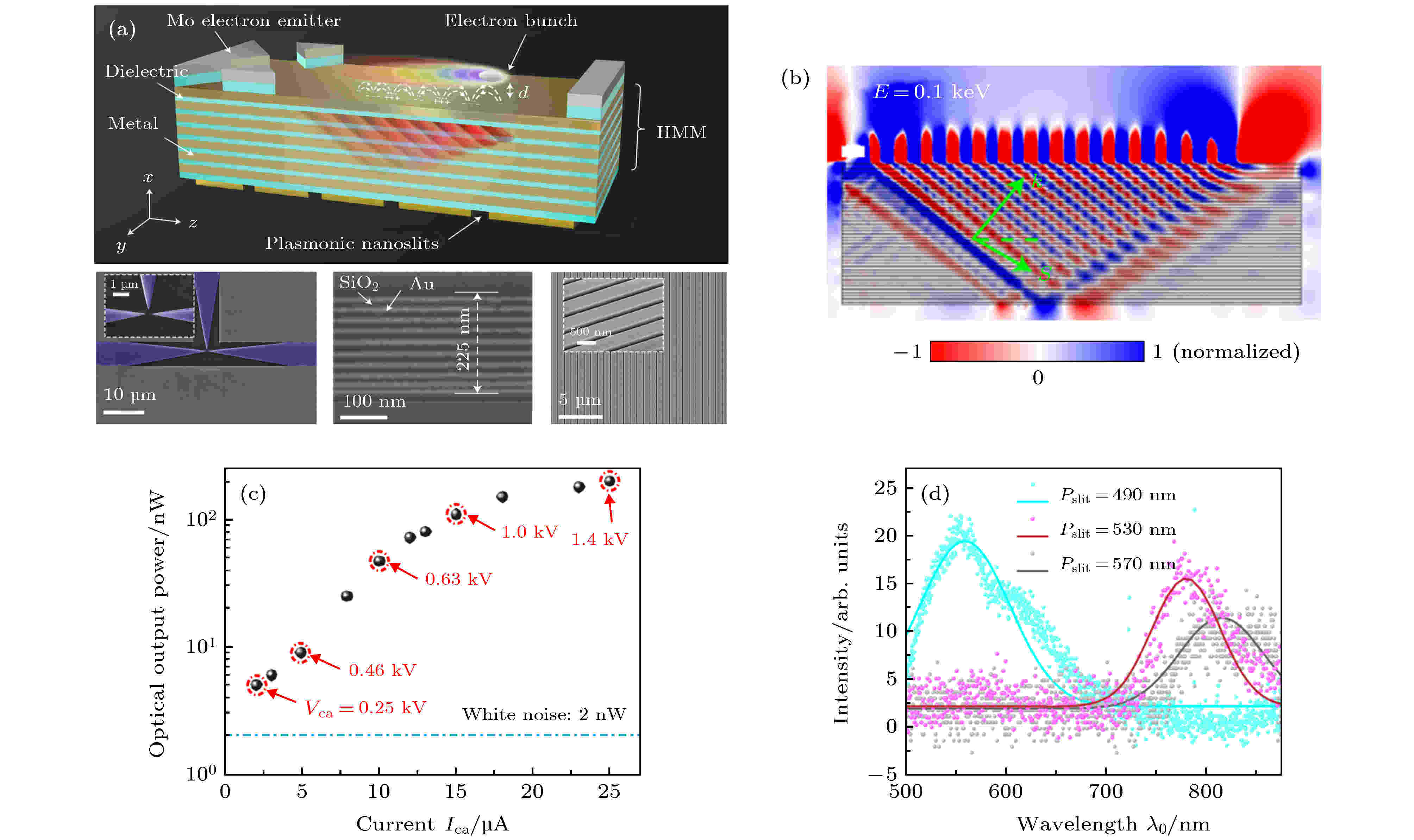 图 3 (a) 集成CR芯片示意图和电子显微镜照片, 器件上表面为钼平面电子发射源, 中间为由Au和SiO2多层膜组成的双曲超材料, 下方为周期金属纳米狭缝用于将CR耦合到自由空间; (b)能量为0.1 keV的自由电子在多层膜双曲超材料中产生CR (电场Ez分量)的仿真结果, 场图对应真空波长为800 nm; (c) 阴阳极电压Vca为0.25—1.4 kV时, 芯片辐射输出功率; (d) 不同纳米缝隙周期Pslit对应的输出光谱; 引自文献[49]
图 3 (a) 集成CR芯片示意图和电子显微镜照片, 器件上表面为钼平面电子发射源, 中间为由Au和SiO2多层膜组成的双曲超材料, 下方为周期金属纳米狭缝用于将CR耦合到自由空间; (b)能量为0.1 keV的自由电子在多层膜双曲超材料中产生CR (电场Ez分量)的仿真结果, 场图对应真空波长为800 nm; (c) 阴阳极电压Vca为0.25—1.4 kV时, 芯片辐射输出功率; (d) 不同纳米缝隙周期Pslit对应的输出光谱; 引自文献[49]Figure3. (a) Schematic of the integrated CR emitter and scanning electron microscopy images. The planar Mo electrodes is on the top surface of the emitter. The hyperbolic metamaterial in the middle is formed by alternating Au and SiO2 films. The plasmonic nanoslits under the emitter are used to couple the CR in the hyperbolic metamaterial to free space; (b) numerical simulation of CR (electric field Ez) with electron energy of 0.1 keV when λ0 = 800 nm; (c) optical output power of the chip with cathode-anode voltage Vca varying from 0.25 to 1.4 kV; (d) spectra of output light with different plasmonic nanoslit period of Pslit. Extracted from Ref. [49]
由于Au的表面等离子体(surface plasmon, SP)共振频率处于可见光和近红外波段, Au-SiO2多层膜结构的双曲区间为可见光和近红外波段[53]. 如果要在其他波段获得双曲超材料中的CR, 需要选取不同等离子体频率的材料来实现超构材料. 几种不同材料的SP共振频率如图4(a)所示[53], 加拿大阿尔伯塔大学Shekhar等[53]为了拓展紫外波段的CR, 对Si材料的等离子体特性进行了研究. 通过电子能量损失谱测得Si膜的SP频率约为11.5 eV (对应真空波长107 nm), 处于极紫外波段, 如图4(c)所示. 进而他们提出利用Si和SiO2的多层膜构造双曲超材料, 并仿真了低能量电子激励的极紫外波段CR.
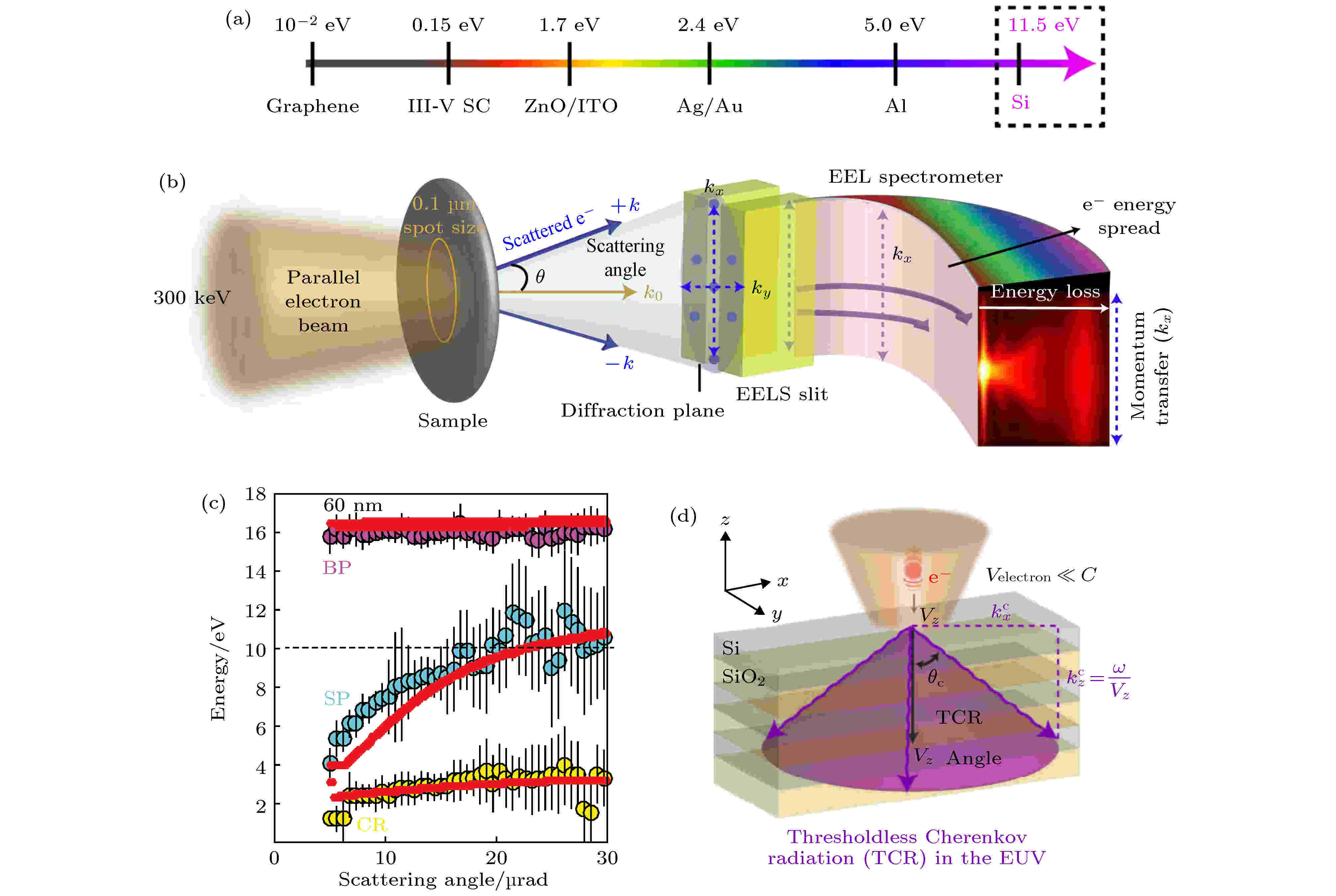 图 4 (a) 从太赫兹到极紫外(extreme ultraviolet, EUV)的范围内, 不同材料的SP共振频率; (b) 电子能量损失谱(electron energy-loss spectroscopy, k-EELS)测量Si膜的光子能带的示意图; (c) 60 nm厚Si膜的光子能带结构测量结果, Si的SP共振频率约为11.5 eV, 处于EUV波段; (d) EUV波段的无阈值CR的示意图, 双曲超材料由Si和SiO2多层膜组成; 引自文献[53]
图 4 (a) 从太赫兹到极紫外(extreme ultraviolet, EUV)的范围内, 不同材料的SP共振频率; (b) 电子能量损失谱(electron energy-loss spectroscopy, k-EELS)测量Si膜的光子能带的示意图; (c) 60 nm厚Si膜的光子能带结构测量结果, Si的SP共振频率约为11.5 eV, 处于EUV波段; (d) EUV波段的无阈值CR的示意图, 双曲超材料由Si和SiO2多层膜组成; 引自文献[53]Figure4. (a) Measured surface plasmon resonance for various materials across the electromagnetic spectrum from terahertz to EUV; (b) schematic showing the k-EELS technique for measuring the photonic band structure of silicon; (c) the photonic band structure of 60 nm thick silicon films. It shows evidence of the SP of silicon in the EUV; (d) schematic of thresholdless CR in the EUV excited in a hyperbolic metamaterial composed of Si and SiO2 multilayer stack. Extracted from Ref. [53].
值得注意的是, 金属-介质多层膜结构中的膜层厚度在远小于CR的波长(即满足亚波长条件)时, 多层膜才能被视为均匀的电磁媒质[48]. 由色散公式(4)可知, 随着电子速度(能量)的降低, 电子周围消逝场波矢增大, 双曲超材料中的CR波长将缩短. 受限于薄膜制备工艺, 当CR波长进一步缩短(电子速度进一步降低)时, 要满足亚波长条件的膜层厚度将难以实现[54,55]. 因此, 实际的双曲超材料中仍然存在一个产生CR的电子速度(能量)的最小值, 特定厚度的金属-介质多层膜结构只能支持一定范围的电磁波矢, 对应激励CR的电子能量的范围.
有趣的是各向异性材料中的h-BN和Bi2Te3等材料, 它们的二维层状结构类似于超构材料的多层膜, 使其天然具有双曲特性[56-58], 并且不少科研人员已经从理论和实验中证实了天然双曲特性可以用于产生CR[59-62]. 由于h-BN内部层状结构可以达到单原子层的厚度, 意味着可以支持更大的电磁波矢和更小的激励CR的电子能量, 理论预测电子能量可以进一步降低到~1 eV的量级[60]. 但由于电子能量过小, 导致h-BN中CR信号的提取和探测存在极大的难度, 因此还未在实验中获得验证. 由上述研究工作可以看到, 双曲材料的引入为低能量自由电子激励不同频段的电磁辐射提供了可能, 有助于真空电子辐射器件的小型化和集成化.
目前已经实现了多种具有负折射率功能的超构材料, 其核心原理在于通过结构设计使超构材料的磁导率和电导率同时小于零[66-68]. 浙江大学奚圣等首次在实验上探索了负折射率材料的反向CR[68], 实验示意图如图5(a)所示[69]. 其中, 正交的金属条提供负电导率, L形金属条构成的开环谐振器提供负磁导率, 整体上组成了在8.1—9.5 GHz之间具有负折射率特性的超构材料. 为了提高电磁辐射强度以便于信号的探测, 实验中用特定频率的天线阵列取代飞行的带电粒子. 图5(c)是不同角度辐射功率的测试结果, 说明了CR与“粒子飞行”方向相反. 加州伯克利大学Zhang等[69]在对该工作的评述中谈及, 用天线阵列取代带电粒子, 其结果本质上体现的是负折射率现象, 要想在实验中直接验证反向CR, 仍需要通过带电粒子和负折射率材料的直接作用.
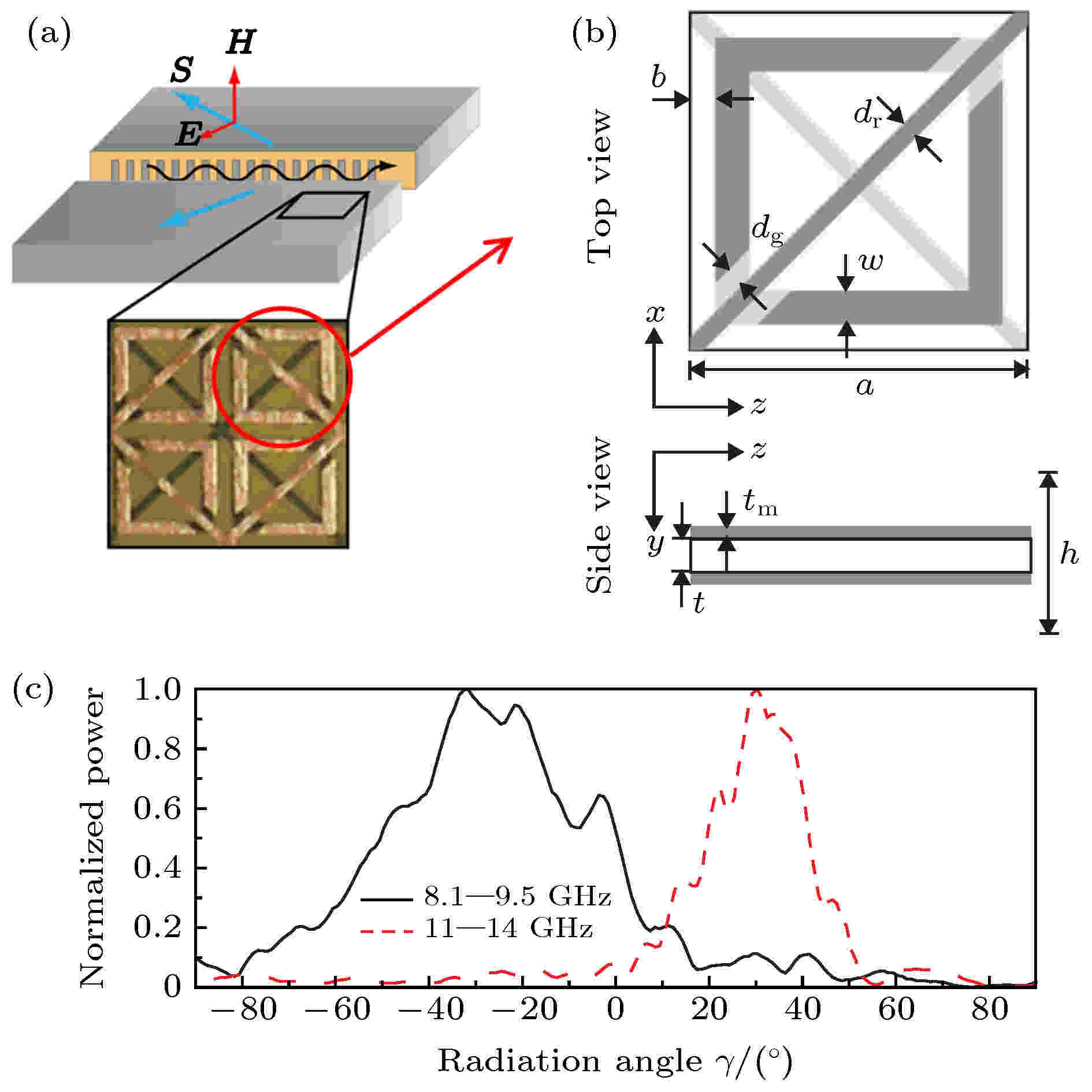 图 5 (a) 反向CR的实验示意图以及负折射率材料的照片; (b) 负折射率材料结构单元的顶视和侧视示意图; (c) 在负折射率(实线)和正折射率(虚线)区间, 辐射功率随角度变化的功率谱; (a)图引自文献[69], (b), (c)图引自文献[68]
图 5 (a) 反向CR的实验示意图以及负折射率材料的照片; (b) 负折射率材料结构单元的顶视和侧视示意图; (c) 在负折射率(实线)和正折射率(虚线)区间, 辐射功率随角度变化的功率谱; (a)图引自文献[69], (b), (c)图引自文献[68]Figure5. (a) Schematic of the experimental configuration used to demonstrate backward CR and the photographic image of the negative index metamaterials; (b) the top and side view of the negative index metamaterials; (c) spectra of the radiation power in each angle in the negative band (solid line) and positive band (dashed line). (a) is extracted from Ref. [69]. (b), (c) are extracted from Ref. [68].
随后, 电子科技大学段兆云等[70]在负折射率材料中首次观测到带电粒子激励的反向CR. 如图6(a)所示, 负折射率材料的器件模型为金属波导内部加载互补开口谐振环. 基于有效媒质理论和数值仿真计算, 图6(b)中自由电子和超构材料色散曲线的交点对应激励起负群速度的电磁辐射, 即CR传播方向与电子运动方向相反. 实验测试频率范围为2.83—3.05 GHz微波波段, 自由电子沿+z方向从器件左侧飞往右侧, 测试结果发现位于左侧的端口2比右侧的端口1的辐射输出高17.6 dB. 这意味着辐射的能流方向与电子飞行方向相反, 验证了自由电子在负折射率材料中反向CR特性.
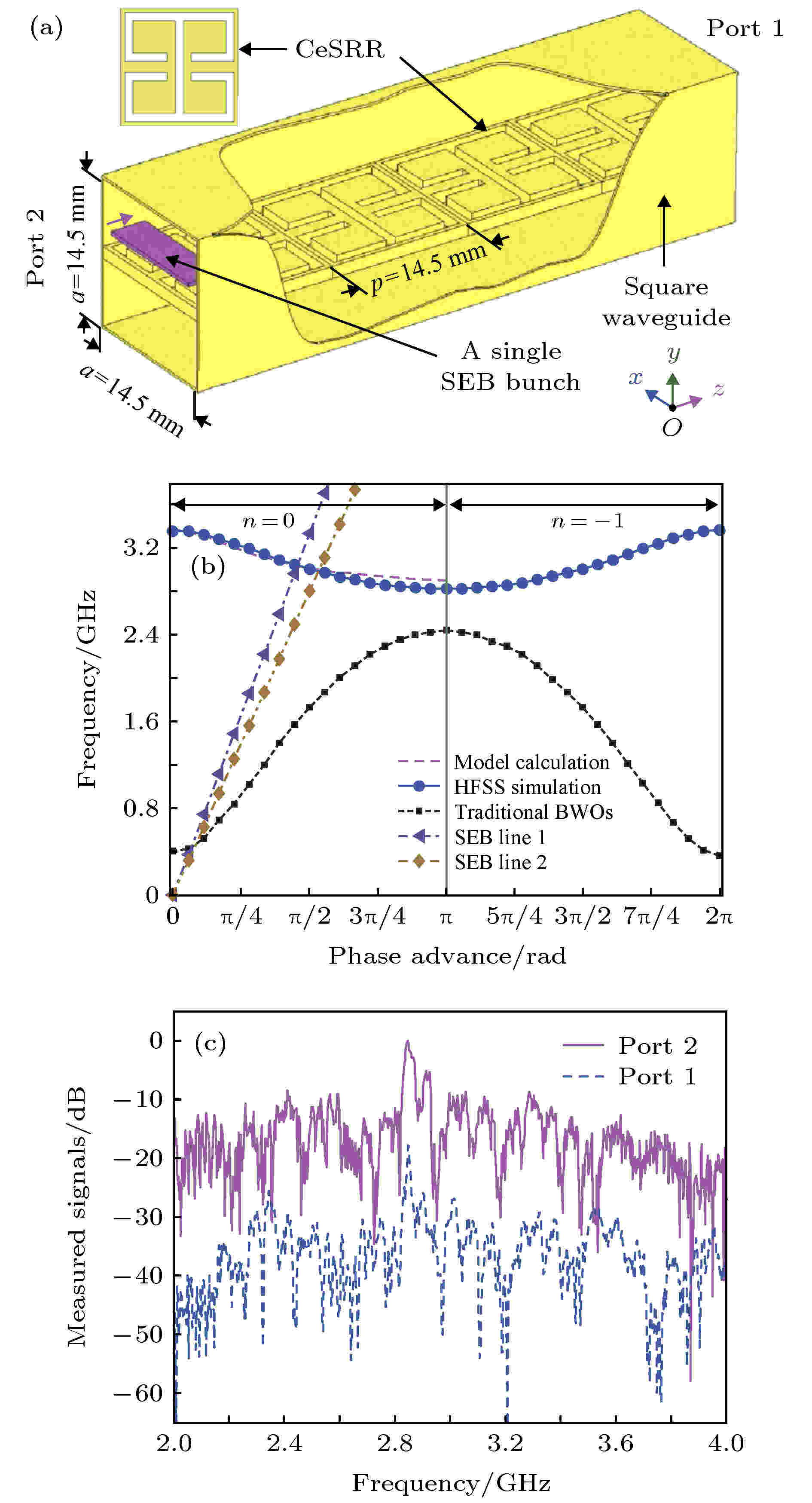 图 6 (a) 反向CR器件构造图, 电子束沿+z方向飞行与器件相互作用; (b) 自由电子和反向CR器件的色散曲线, 负折射率材料的色散曲线通过模型计算和高频结构仿真软件(HFSS)仿真得到; (c) 在端口2和端口1测试反向CR器件的功率谱分布; 引自文献[70], 并在(a)中标记了位于左侧的“Port 2”和右侧的“Port 1”
图 6 (a) 反向CR器件构造图, 电子束沿+z方向飞行与器件相互作用; (b) 自由电子和反向CR器件的色散曲线, 负折射率材料的色散曲线通过模型计算和高频结构仿真软件(HFSS)仿真得到; (c) 在端口2和端口1测试反向CR器件的功率谱分布; 引自文献[70], 并在(a)中标记了位于左侧的“Port 2”和右侧的“Port 1”Figure6. (a) Schematic diagram of the constructed structure interacting with a single sheet electron beam bunch travelling along the +z direction; (b) dispersion curves characterized by frequency versus phase advance. The dispersion curve of the negative metamaterial is obtained by model calculation and high frequency structure simulator (HFSS) simulation; (c) measured power spectral densities of the reversed Cherenkov radiation and its reflection signals at ports 2 and 1. Extracted from Ref. [70] with “Ports 2” and “Port 1” marked in (a).
在粒子物理学中, CR可以用来检测带电粒子的速度、动能以及电荷量等参数[71-73]. 但是传统CR的传播和粒子速度同向, 不可避免地会给信号探测带来干扰[74]. 负折射率材料可以用一种新的方式调控自由电子的辐射角, CR方向与电子飞行方向呈现大于90°的钝角关系. 基于负折射率材料的反向CR可以有效分离粒子和辐射信号, 从而减小粒子检测器的干扰, 提高探测灵敏度[74,75].
韩国首尔大学Kim等[77]在实验中实现了微波波段具有高Q值Fano共振特性的金属超构材料. 图7(a)和图7(b)是两种非对称结构的超构材料示意图, 材料结构由金属狭缝构成, 非对称的结构设计使得超构材料的透射谱存在Fano共振, 对应的Q值可以达到700左右. 正是借助高Q值的Fano共振, 他们在理论上研究了自由电子和超构材料的相互作用可以实现受激CR. 仿真所用的电子能量为10.43 keV, 电流密度2 A/cm2, 电子束在超构材料表面发生群聚, 产生频率为34.3 GHz的受激辐射.
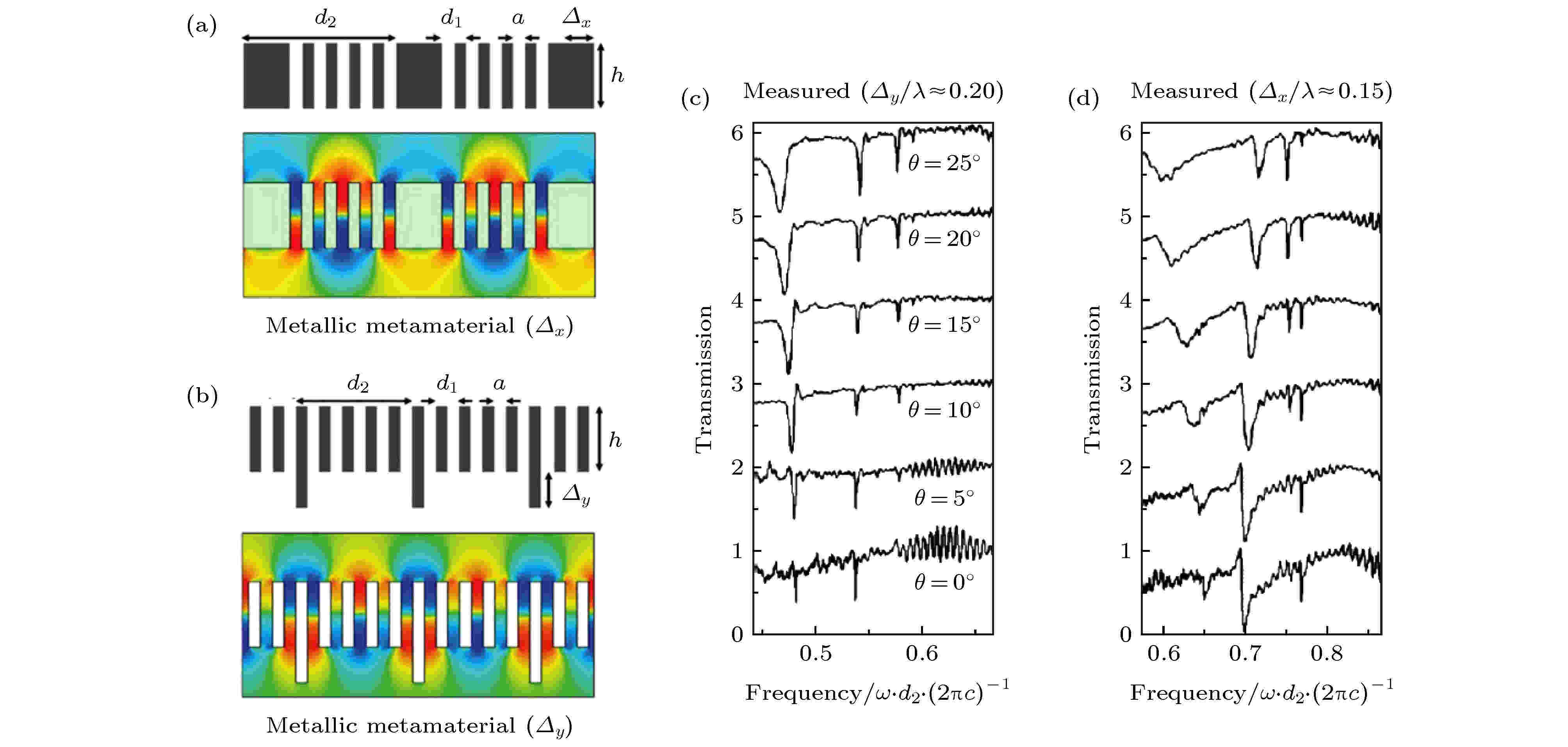 图 7 (a)和(b)是两种非对称结构的Fano共振金属超构材料, 超构材料由亚波长的金属狭缝构成; (c)和(d)是不同入射角度下, 两种非对称结构的透射谱结果, 透射谱中的四个低峰表示p偏振光激励的Fano共振; 引自文献[77]
图 7 (a)和(b)是两种非对称结构的Fano共振金属超构材料, 超构材料由亚波长的金属狭缝构成; (c)和(d)是不同入射角度下, 两种非对称结构的透射谱结果, 透射谱中的四个低峰表示p偏振光激励的Fano共振; 引自文献[77]Figure7. (a), (b) Fano-enhanced metallic metamaterials consisting of subwavelength slits with two different structural asymmetries; (c), (d) transmission results with different angles of incidence and structural asymmetries. The four sharp dips represent the excitation of the Fano resonance by capturing the p-polarized incident wave. Extracted from Ref. [77].
麻省理工学院Yang等[79]则提出利用光子连续区束缚态(bound states in the continuum, BICs)增强SPR强度. 光学BIC的频率处于“辐射连续区域”内, 却仍能被束缚在周期结构中, 并表现出超高的品质因子Q [76,80,81]. 该工作通过设计Si光栅周期结构, 使得与电子相位匹配的模式处于BIC态. 借助BIC的高Q值, 同时得益于Si光栅的低介质损耗, 自由电子的SPR辐射强度增强约3个数量级. 复旦大学胡新华课题组[78]的工作中, 进一步阐述了基于Si的双排光栅结构相比于单排光栅结构可以提高BIC的Q值. 图8(e)所示模拟仿真结果表明, 通过调整双排Si介质光栅之间的距离, 理论上可以实现极大的Q值, 与自由电子之间的强相互作用为小型化的CR激光奠定了理论基础.
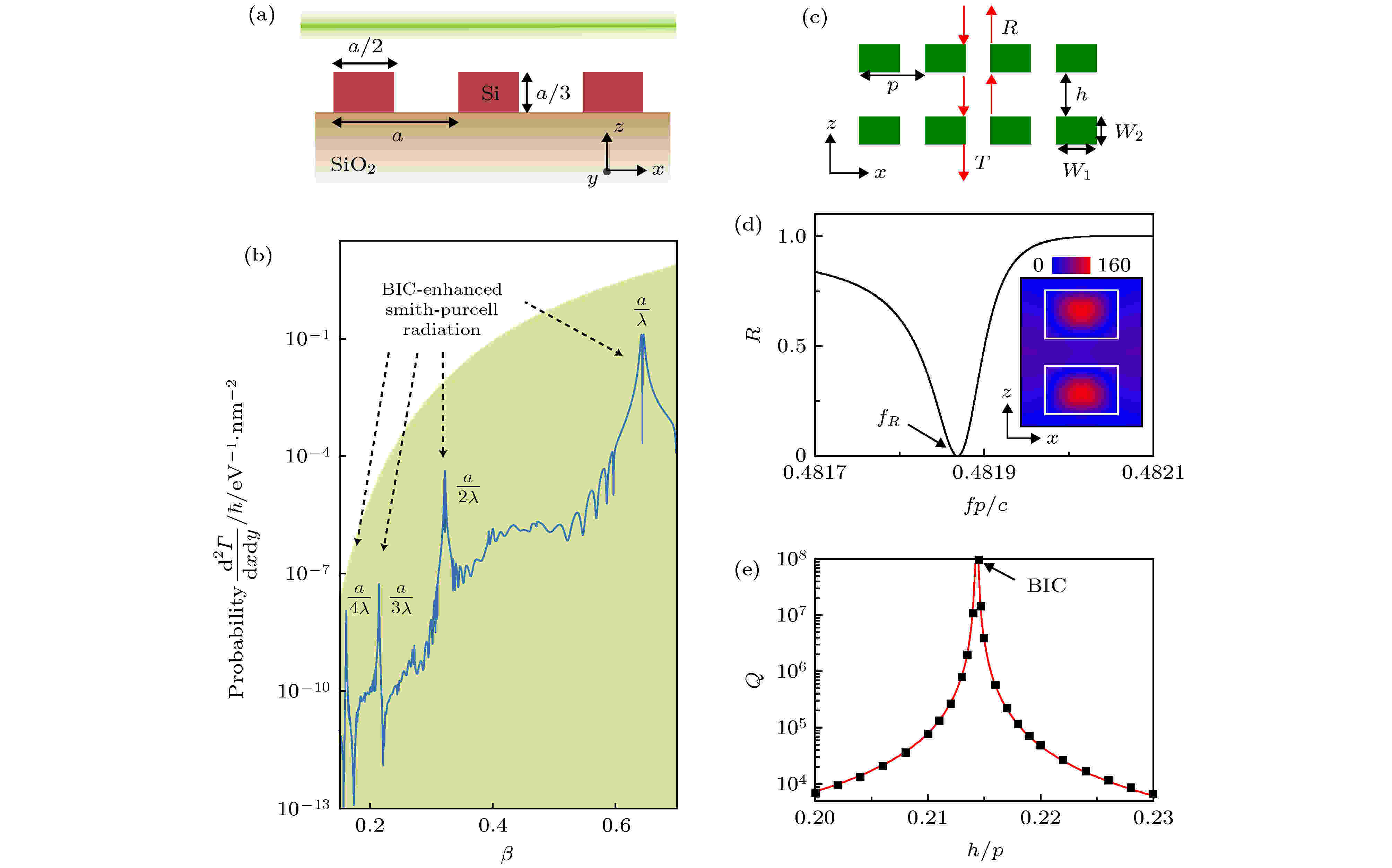 图 8 (a) 自由电子飞过Si周期光栅的示意图; (b) 在给定频率下不同电子速度的辐射强度, BIC附近的SPR得到极大增强; (c) 平面波入射双排Si介质光栅示意图; (d) 归一化频率下介质光栅的反射系数R, 插图为共振频率处| Hy |场图; (e) 共振频率fR的品质因子Q随光栅间距h的变化关系; (a), (b)图引自文献[79]; (c)?(e)图引自文献[78]
图 8 (a) 自由电子飞过Si周期光栅的示意图; (b) 在给定频率下不同电子速度的辐射强度, BIC附近的SPR得到极大增强; (c) 平面波入射双排Si介质光栅示意图; (d) 归一化频率下介质光栅的反射系数R, 插图为共振频率处| Hy |场图; (e) 共振频率fR的品质因子Q随光栅间距h的变化关系; (a), (b)图引自文献[79]; (c)?(e)图引自文献[78]Figure8. (a) Schematic of free electrons flying over a silicon-on-insulator grating; (b) emission probability at a given frequency for different electron velocities, and strongly enhanced SPR near the BIC; (c) schematic of the normal impinging of a propagating plane wave upon a double silicon grating; (d) specular reflection coefficient R as a function of normalized frequency. Inset: the profile of |Hy| at resonant frequency. (e) Q factor at fR as a function of the distance h. (a), (b) are extracted from Ref. [79]. (c)?(e) are extracted from Ref. [78].
上述工作都提到了超构材料的受激CR, 其受激放大过程是电磁辐射与自由电子实现能量交互的正反馈过程[82-84]. 在一定情况下, 自由电子和电磁辐射之间存在极强的相互作用, 电子束流受到电磁辐射的调制形成周期性群聚电子团[85-87], 群聚电子周围消逝场的相干性增强[85], 产生频谱更窄、强度更高的辐射, 最终实现受激辐射.
无论是Fano共振还是光子BIC态, 目的都是想借助高Q值结构实现特定频率的电磁辐射与自由电子的强相互作用. 然而, 为了在微纳尺度精准控制电子束斑以及与超构材料之间的作用距离, 电子束流通常较低而导致辐射太弱, 不足以反馈调制自由电子而形成足够的增益[88]. 因此, 利用高Q值低损耗的结构来实现集成化的自由电子激光器极其具有探索意义和挑战性.
基于传统周期结构的SPR为TM极化辐射, 美国东北大学Wang等[93]用如图9(a)所示的金属C形孔谐振器设计的超表面来调控SPR的极化特性. 在传统的C形环谐振器中, 自由电子激励起的是平面内的电偶极子和垂直于平面的磁偶极子(图9(c)), 导致辐射场的偏振为不可调控的TM极化. 基于Babinet原理, C形孔(图9(b))与C形环谐振器为互补结构, 自由电子在互补结构中首先激励起垂直于平面的电偶极子, 电偶极子会在C形孔谐振器内耦合产生平面内的磁偶极子. 磁偶极子的方向与C形孔的开口方向相关, 当开口方向α = 0°, 磁偶极子垂直于电子飞行方向, SPR为TM极化场; 当α = 90°, 磁偶极子平行于电子飞行方向, 对应为TE极化场. 通过C形孔谐振器超表面, SPR偏振态突破了传统TM的限制. 基于上述的理论研究工作, 麻省理工学院Yang等[94]在实验中利用C形光学天线产生SPR, 并实现对光学波段SPR的偏振调控.
 图 9 (a) 自由电子和Babinet超表面作用产生SPR的示意图, 均匀带电粒子在超表面上方沿+ x轴方向飞行; (b)和(c)分别是C形孔结构和环结构的超表面, 以及自由电子产生SPR的电场分布模拟结果; 引自文献[93]
图 9 (a) 自由电子和Babinet超表面作用产生SPR的示意图, 均匀带电粒子在超表面上方沿+ x轴方向飞行; (b)和(c)分别是C形孔结构和环结构的超表面, 以及自由电子产生SPR的电场分布模拟结果; 引自文献[93]Figure9. (a) Schematic of the SPR produced by the interaction of free electrons and a Babinet metasurface. The uniform sheet of free electrons moves closely parallel to the metasurface along the +x axis; (b), (c) the structures of C-aperture and C-ring metasurfaces, and the electric field distributions of SPR generated via the interaction with free electrons. Extracted from Ref. [93].
除了对SPR偏振特性的调控, 美国东北大学Su等[95]提出利用石墨烯超表面对辐射场进行相位、振幅以及偏振态的控制. 石墨烯的超表面模型如图10(a)所示, 从上到下分别为石墨烯带状结构、介质层以及金属反射层, 自由电子在石墨烯带状结构表面飞行激励SPR. 由于石墨烯结构的等离子体共振, 通过改变石墨烯的宽度w可以实现SPR归一化强度从0到1的控制(图10(b)); 同时, 辐射的相位与石墨烯所在单元结构中的位置Δx相关, 调整石墨烯的位置可以调控SPR二阶辐射的相位在–π至+π范围内变化(图10(c)); 此外改变自由电子和石墨烯相互作用的角度α, 辐射场偏振特性可以被调控, Ex和Ey分量的强度和相位随着α不同而改变(图10(d)), 以此实现不同偏振态的SPR.
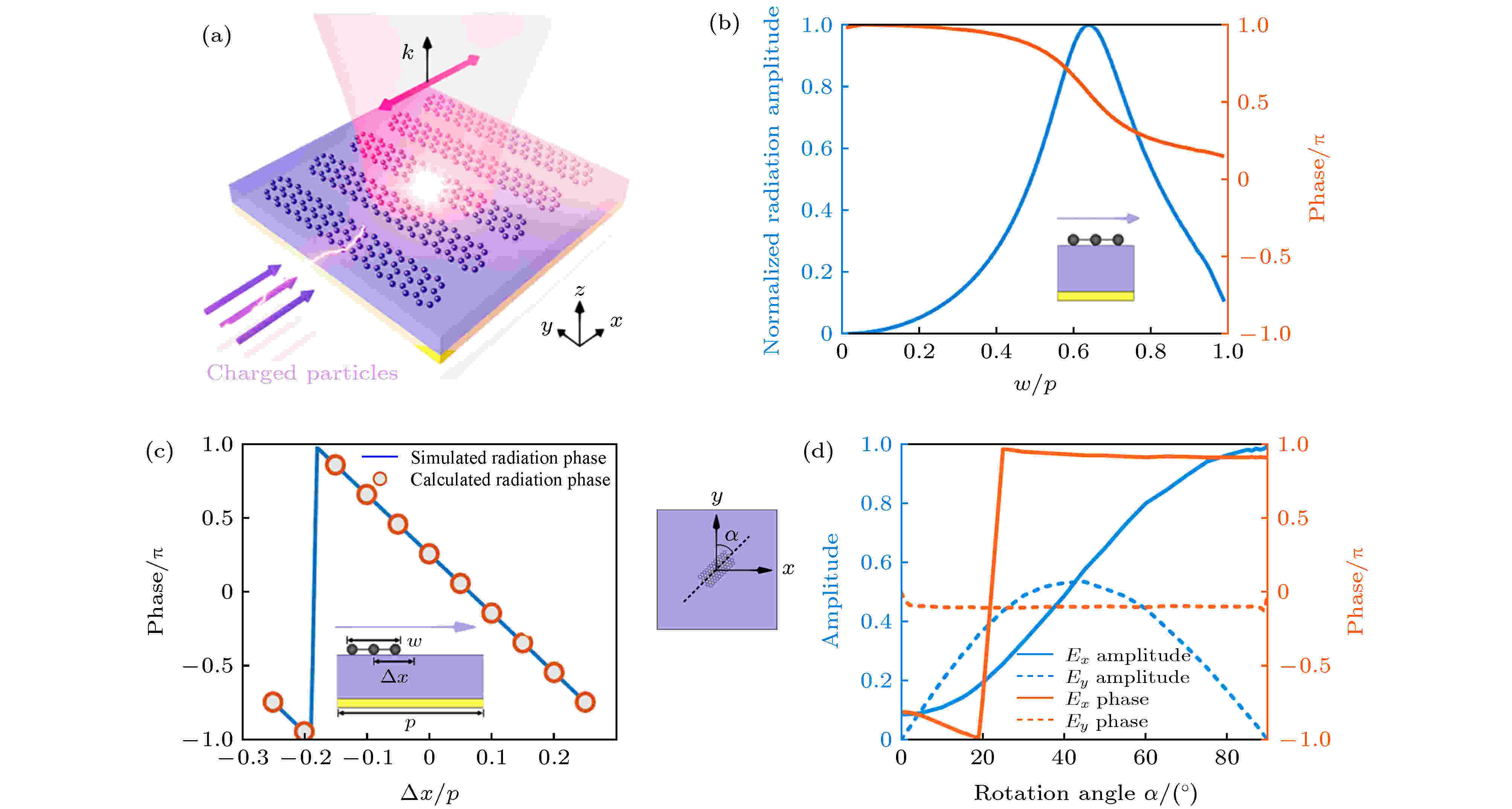 图 10 (a) 基于石墨烯超表面产生SPR的示意图; (b) SPR辐射强度、相位与石墨烯带状结构宽度w的关系; (c) SPR二阶辐射相位与石墨烯在单位结构中位置Δx的关系; (d) SPR的Ex和Ey分量的强度和相位与石墨烯的旋转角度α之间的关系; 引自文献[95]
图 10 (a) 基于石墨烯超表面产生SPR的示意图; (b) SPR辐射强度、相位与石墨烯带状结构宽度w的关系; (c) SPR二阶辐射相位与石墨烯在单位结构中位置Δx的关系; (d) SPR的Ex和Ey分量的强度和相位与石墨烯的旋转角度α之间的关系; 引自文献[95]Figure10. (a) Schematic of SPR mediated by graphene metasurfaces; (b) dependence of the SPR amplitude and phase on the width of the graphene ribbons; (c) dependence of the SPR phase on the displacement of a graphene ribbon in its unit cell for the second-order SPR; (d) dependence of the amplitude and phase of electric field Ex and Ey on the rotating angle of rectangular graphene patches. Extracted from Ref. [95].
本文只是回顾了这一研究方向上的初步研究工作, 超构材料在发展过程中还会不断地融合新的材料和结构, 仍有许多电子辐射的新现象、新机理和新特性有待挖掘. 可以期待, 超构材料的引入将提升现有器件的性能, 并获得多种新型的自由电子器件. 例如, 现有电真空器件工作频率处于微波波段, 随着频率提高到太赫兹波段, 辐射功率显著下降. 借助电磁谐振结构、二维材料、表面等离激元模式、以及微加工技术[28,96-99], 构建太赫兹波段的超构材料, 有可能获得高频太赫兹电真空器件. 目前, 超短波长、集成化自由电子辐射光源也是国内外研究热点, 片上集成的自由电子受激辐射源还局限在理论探索. 基于高功率激光和超构材料的电子加速、群聚以及运动轨迹的调制获得关注和发展[100-103], 为新型的自由电子激光器提供了可能. 此外, 尽管之前的工作初步探索了半导体异质结的二维电子气或石墨烯薄膜的准自由电子的辐射[104-107], 但是固态材料中的准自由电子能否像真空自由电子一样产生CR仍然是一个有待研究的问题. 有趣的是, CR的概念还被引入到非线性光学领域, 用高能激光代替带电粒子, 产生诸如光学超晶格中的非线性CR[108-111], 以及基于孤子CR的光频梳现象等[112-114], 这些现象有助于新型光电子学器件的研发, 拓展了CR的应用领域.
传统真空电子学与正在新兴的微纳光电子学的交叉融合, 为突破自由电子产生辐射的限制条件、拓展辐射频率、调控辐射偏振和相位、操控自由电子的能量和空间分布、以及实现全新形式的自由电子辐射和加速器件提供了可能. 期待更多创新工作的涌现, 推动这一交叉学科的发展.
